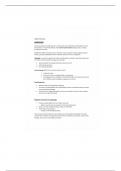Chapter 9 Summary
LANGUAGE
Humans dominate the world because we communicate more effectively and think better than do
other animals – we have the ability to create mental representations (images, ideas, concepts,
principles) of the world.
COGNITION - higher mental processes or thinking - memory, problem solving, language, decision-
making, reasoning. LANGUAGE has been called the ‘jewel in the crown of cognition’.
Language is a system of symbols and rules for combining these symbols in ways that can generate
an infinite number of possible messages and meanings.
allows individuals to exchange information about the world
coordinate group action
form strong social bonds
Human language differs from any other species in that it:
complex structure
use words to refer to intangible things, e.g. democracy
use language to name, categorize, and describe things to ourselves when we think,
which influences how knowledge is organized in our brains
Psycholinguistics
Scientific study of the psychology of language
The study of the psychological and neurobiological factors that enables humans to acquire,
use and understand language
Initial forays were largely philosophical ventures, due mainly to a lack of cohesive data on
how the human brain functioned
Adaptive Functions of Language
Evolved as people gathered to form larger social units
- Made it easier for humans to adapt to environmental demands
Allows us to share thoughts, feelings, needs, etc. with others
Powerful learning mechanism
- Passing on of knowledge & wisdom
As the social environment became more complex, new survival problems emerged: the need to
create divisions of labour and cooperative social systems, to develop social customs, communicate
thoughts, and to pass on knowledge and wisdom
, Properties of language
What is striking about the world’s languages is not their differences but the host of complex skills
which underlie language, that they share, yet it comes as naturally as breathing
Language consists of symbols (that convey meaning)
Rules for combining those symbols
- This can be used to generate an infinite variety of messages and meanings
Four properties essential to language:
Symbolic (arbitrary)
Structured / rule-governed
Semantic (meaning)
Generative
A fifth property discussed is language: Permits displacement
Language is Symbolic and Structured
Language uses sounds, written characters or some other system of symbols to represent
objects, events, ideas, feelings and actions. The symbols used in any given language are
arbitrary. Language also has a rule-governed structure. A language’s grammar is the set of
rules that specify how the units of language can be combined to produce meaningful
messages.
rules of morphology (indicate how morphemes can be combined to form words)
rules of syntax (rules that govern the order of words)
Language conveys Meaning
No matter the arbitrary symbols or grammatical rulws used, once people learn those symbols
and rules, they are able to form and then transfer mental representations to the mind of
another person.
Semantics = meaning of words and word combinations (sentences)
Relationship between language & what it represents
Language is Generative and Permits Displacement
Generativity – the symbols of language can be combined to generate an infinite number of
messages that have novel meaning
Displacement – refers to the fact that language allows us to communicate about events and
objects that are not physically present. Thus language frees us from being restricted to
focussing on events and objects that are right before us in the present.
The structure of language
Surface structure and deep structure





